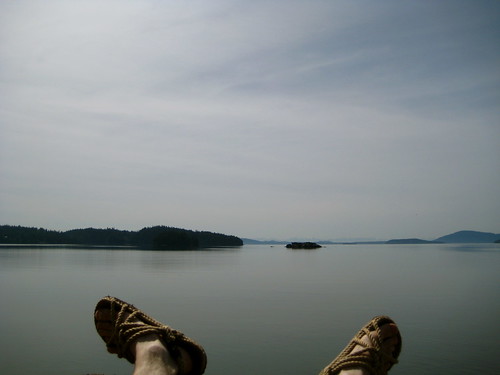Rope Sandal Hike
Today was forecast to be 65 degrees Fahrenheit and sunny. Of course, that meant I had to go on a hike. To celebrate the weather, I decided to do the hike in my Nomadic State of Mind JC rope sandals, which I’ve previously mentioned elsewhere.
I was given the sandals a few years ago and always toss them in my pack when traveling in warmer climates. They’re light enough to not weight down the pack, and function as excellent camp shoes at the end of the day. I’ve never done any serious hiking with them though, and I wanted to see how capable they (and I) were.
I ended up doing a 15 mile hike. Towards the end, the balls of both my feet felt a little sore. They feel as if they’re developing a new callus (good thing) rather than a blister (bad thing).
I think it’s a healthy habit to do a hike every now and again with minimal-to-no foot support (such as barefoot, or with sandals similar to these). We all know that shoes are supposed to be bad things. If you’re the type who wears 6” or taller boots everyday, it’s especially important. Combat boots provide so much support for the foot and ankle that the muscles and tendons don’t have to do any work. They waste away. Walking with less supportive footwear will allow your feet to develop to a more healthful level.
For myself, I was surprised to find that the muscles in my lower back seemed to get the greatest workout. I usually have very bad posture, but walking with the sandals, for some reason, forced me to stand straighter than usual.
I decided to bring the Kifaru E&E instead of my normal EDC pack to cut down on weight. Here’s what I carried in it:
- Joby Gorillapod
- TAD Gear BC-8 pouch
- Canon Powershot SD1000
- Klean Kanteen (40 oz)
- Possibles pouch
- Challah (1/2 loaf)
- Grimloc Carabiner (2x)
- Bushcraft Northwest BCNW-O1 knife
- Filson Tin Cloth Packer Hat
- Minimalist Self-Aid kit
- Buff
- The Wilderness Tactical Halfway-Decent Glasses Case
- Julby Micropore
- Glasses strap
- Lens cloth
- TAD Gear BC-8 pouch
- Silva Ranger CL compass
- Trail Mix
- Pendleton Western lightweight wool shirt
- Nature and Walking, Emerson and Thoreau
...most of my townsmen would fain walk sometimes, as I do, but they cannot. No wealth can buy the requisite leisure, freedom, and independence, which are the capital in this profession. It comes only by the grace of God. It requires a direct dispensation from heaven to become a walker. You must be born into the family of the Walkers. Ambulator nascitur, non fit. Some of my townsmen, it is true, can remember, and have described to me some walks which they took ten years ago, in which they were so blessed as to lose themselves for half an hour in the woods, but I know very well that they have confined themselves to the highway ever since, whatever pretensions they may make to belong to this select class. No doubt, they were elevated for a moment as by the reminiscence of a previous state of existence, when even they were foresters and outlaws. Henry David Thoreau

